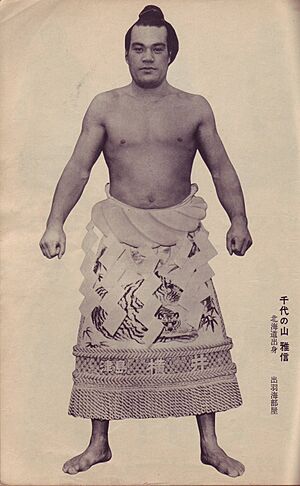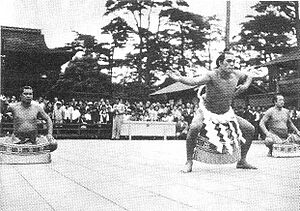Chiyonoyama Masanobu facts for kids
Quick facts for kids Chiyonoyama Masanobu |
|
|---|---|
| 千代の山 雅信 | |

Script error: The function "getImageLegend" does not exist.
|
|
| Personal information | |
| Born | Sugimura Masaharu June 2, 1926 Fukushima, Hokkaidō, Japan |
| Died | October 29, 1977 (aged 51) Sapporo, Japan |
| Height | 1.90 m (6 ft 3 in) |
| Weight | 122 kg (269 lb) |
| Career | |
| Stable | Dewanoumi |
| Record | 403-158-147 (2 draws) |
| Debut | January 1942 |
| Highest rank | Yokozuna (May 1951) |
| Retired | January 1959 |
| Elder name | Kokonoe |
| Championships | 6 (Makuuchi) 2 (Jūryō) |
| Special Prizes | Outstanding Performance (1) Fighting Spirit (1) |
| Gold Stars | 3 Haguroyama Terukuni Maedayama |
| * Up to date as of June 2020. | |
Chiyonoyama Masanobu (Japanese: 千代の山 雅信, June 2, 1926 – October 29, 1977) was a famous Japanese professional sumo wrestler. He came from Fukushima, Hokkaidō. He became the 41st yokozuna, which is the highest rank in sumo. He held this top rank from 1951 until 1959.
Chiyonoyama is seen as the first "modern" yokozuna. This is because the Japan Sumo Association itself promoted him. Before him, a special family called the House of Yoshida Tsukasa usually gave this permission. He was also the very first yokozuna from Hokkaidō. Many other great yokozuna like Taihō and Chiyonofuji also came from Hokkaidō. After he stopped wrestling, he started his own sumo training stable, called Kokonoe stable, in 1967. He passed away in 1977 while still working as a stablemaster.
Contents
Chiyonoyama's Sumo Journey
Chiyonoyama was born Sugimura Masaharu. He was the fifth son in his family. His father was a squid fisherman. He started his sumo training at Dewanoumi stable in January 1942. Early in his career, Chiyonoyama hurt his knee. This injury caused him problems throughout his wrestling life.
He reached the second-highest division, called jūryō, in November 1944. Then, he made his debut in the top makuuchi division in November 1945. He admired the great yokozuna Futabayama. However, Futabayama retired during Chiyonoyama's first top division tournament. So, Chiyonoyama never got to wrestle him. In his first tournament, he won all ten of his matches. But he did not win the championship. Back then, if there was a tie, the wrestler with the higher rank won. In this case, it was yokozuna Haguroyama.

In May 1949, Chiyonoyama showed his strength. He defeated three yokozuna in one tournament. He finished with a great record of 12 wins and 3 losses. After this, he was promoted to ōzeki, the rank just below yokozuna. He then won two championships in a row, in October 1949 and January 1950.
Even with these wins, he was not promoted to yokozuna right away. The Sumo Association thought he was too young at 23. They also wanted to see him win with an even better record. They wanted to be sure he was truly ready for the highest rank.
Chiyonoyama finally became a yokozuna in May 1951. This happened after he won his third championship. He had an impressive record of 14 wins and only 1 loss. He was the first yokozuna to be promoted without the old tradition of getting a special license.
During his time as yokozuna, Chiyonoyama often missed matches due to his knee injury. In 1953, he even asked to be lowered back to ōzeki rank. He wanted to start over and rebuild his strength. But the Sumo Association said no to this unusual request. Chiyonoyama won his first championship as a yokozuna in January 1955. He won two more championships after that, in March 1955 and January 1957. His knee injury got worse and worse. Sometimes, he could barely walk because of the pain. He decided to retire in January 1959.
Life After Wrestling
Chiyonoyama had hoped to become the head coach of Dewanoumi stable. This was after the previous head coach passed away in 1960. However, he was considered too young for such a big job at 34. Another former wrestler, Dewanohana, became the new head.
Later, when yokozuna Sadanoyama married Dewanohana's daughter, Chiyonoyama realized he would not get to lead the stable. So, he asked for permission to leave and start his own stable. This was a big deal because the Dewanoumi group of stables usually did not let wrestlers leave. But they allowed it, as long as he also left their group.
In March 1967, Chiyonoyama opened his new stable, Kokonoe stable. He took ōzeki (who later became yokozuna) Kitanofuji and nine other young wrestlers with him. In 1970, another future yokozuna, Chiyonofuji, joined the stable. Chiyonofuji was also from Fukushima, Hokkaidō. Chiyonoyama sadly passed away from liver cancer in 1977 at age 51. He did not get to see Chiyonofuji reach the yokozuna rank. However, Chiyonoyama's wife attended Chiyonofuji's promotion ceremony in 1981.
Chiyonoyama's Fighting Style
When he first started wrestling, Chiyonoyama was known for his powerful tsuppari attacks. This is a style where a wrestler uses strong thrusts with their hands. But as he worked towards becoming yokozuna in 1951, he improved his yotsu-sumo skills. This style focuses on grappling and holding the opponent. He learned from former yokozuna Tochigiyama and his own coach, former yokozuna Tsunenohana.
Chiyonoyama liked to get a migi-yotsu grip. This means he would grab his opponent's mawashi (belt) with his left hand on the outside and his right hand on the inside. His favorite winning move, called kimarite, was uwatenage. This is an overarm throw.
Images for kids
See also
- Glossary of sumo terms
- List of past sumo wrestlers
- List of sumo tournament top division champions
- List of yokozuna


